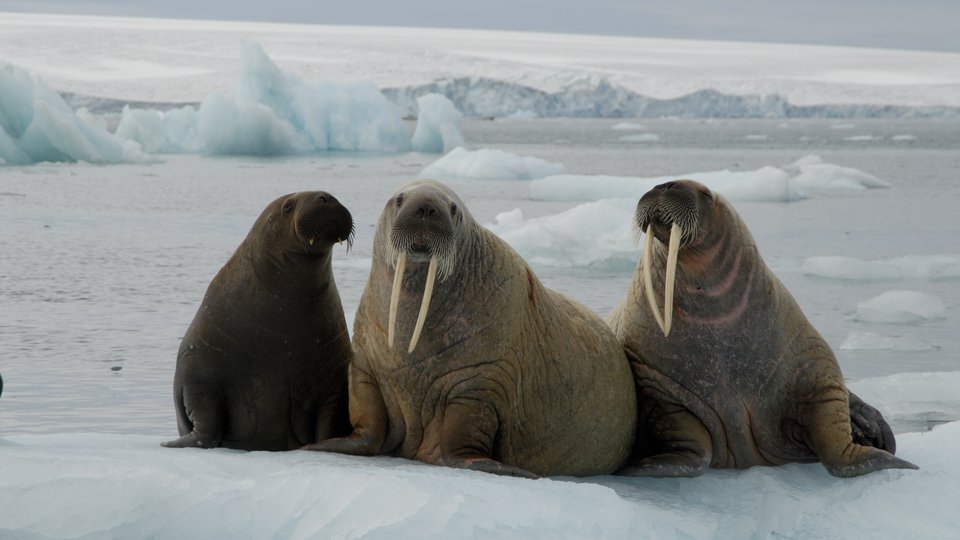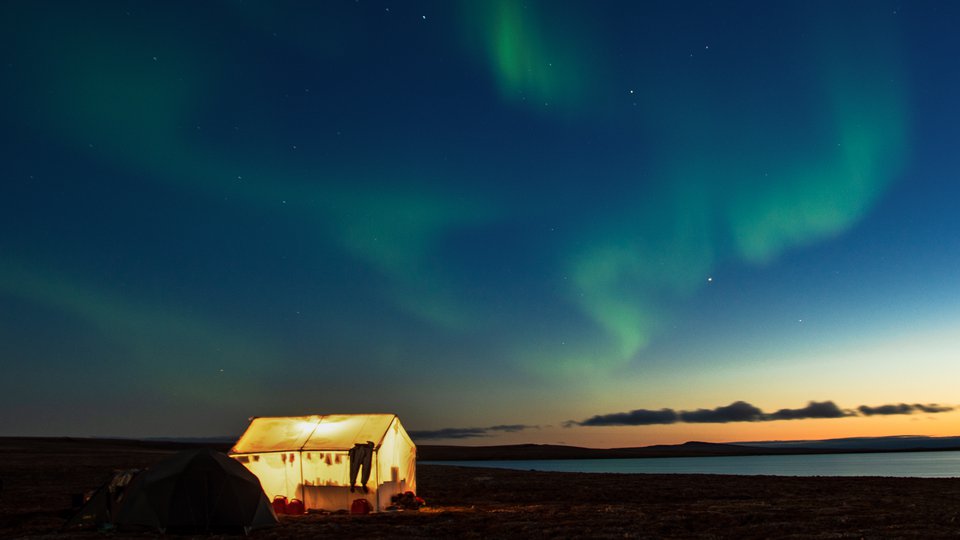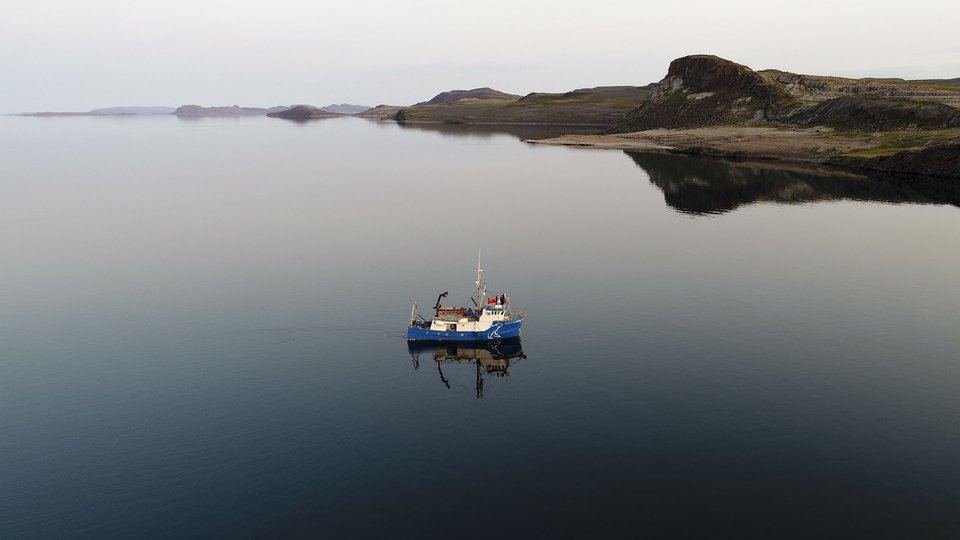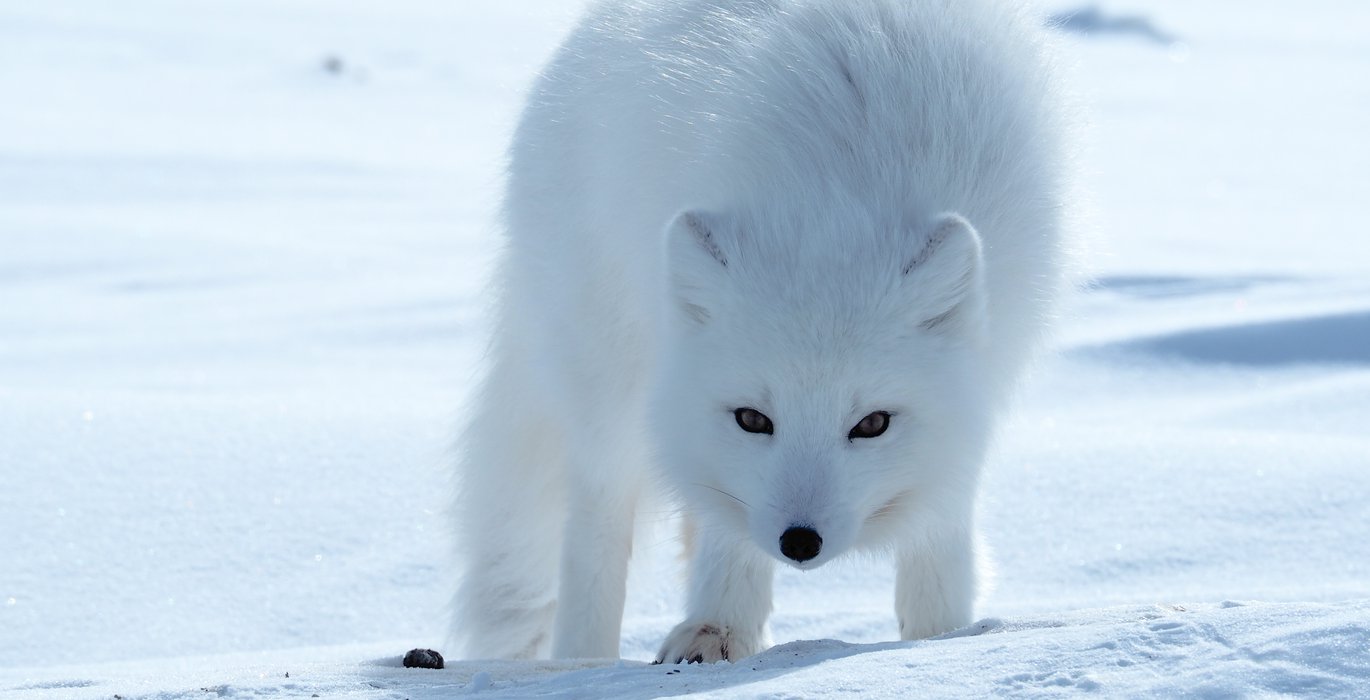
rctic ecosystems and wildlife are increasingly being affected by climate change. As winters get warmer, multiple negative consequences arise for native tundra species. Southern species that once could not face harsh tundra winters are expanding northward as winters become milder. As the Arctic waters warm, mercury goes through a process called methylation, creating methylmercury, which may have dire consequences on wildlife health (for more information about mercury in the Arctic read this article). Finally, southern species settling on the tundra may bring diseases with them, some of which are new to native tundra species, and may have direct repercussions on native species health.
Churchill, Manitoba and Wapusk National Park are located at the Arctic’s edge and are home to a prominent tundra dweller, the Arctic fox. Arctic foxes’ prey are declining and possible competition with red foxes is increasing. Red foxes have recently moved onto the tundra, which may be a problem for Arctic foxes as red foxes are highly similar to the Arctic fox but are a larger and superior predator. In Scandinavia the Arctic fox is endangered, and competition with red foxes, has weakened their remaining populations. However, we do not know how red foxes are impacting Arctic foxes in the Canadian Arctic.
Arctic foxes are native to the tundra and are found across polar regions where they are the main land predator throughout the Arctic. Arctic foxes primarily hunt rodents such as lemmings and voles. Rodent populations fluctuate drastically between years, with years of high rodent density followed by years of low rodent density. During winters, thick snow cover allows rodents to remain active, foraging and reproducing all winter long under the warmth of the snow cover. But as winters become milder and shorter, melt-freeze and flooding events increase, degrading the quality of snow and therefore compromising rodent survival and reproduction. Rodent populations are no longer fluctuating, or even reaching historic high rodent densities, instead they remain consistently low.
Arctic fox populations fluctuate closely following these rodent population cycles. When rodent populations are high, Arctic foxes have many pups (in Canada the average is 10 pups per litter!). In contrast, when rodent populations are low, Arctic foxes may not find enough food to reproduce or to feed the pups they have produced. As a result, very few pups will reach adulthood. During winters when rodents are scarce, Arctic foxes venture out onto the sea ice to forage, sometimes up to several hundreds of kilometers, either following polar bears to scavenge on seal carcasses or hunting ringed seal pups. Consuming marine resources helps Arctic foxes to reproduce, partly compensating for the lack of rodents. Unfortunately, by consuming marine items they also increase their consumption of methylmercury, which may cause health and reproduction problems. But as the Arctic continues to warm, sea ice is declining in duration, limiting Arctic fox’s access to marine prey. Declines in rodent populations and sea ice duration will likely create serious food shortage for the Arctic fox, as there is little to consume on the tundra during the winter.
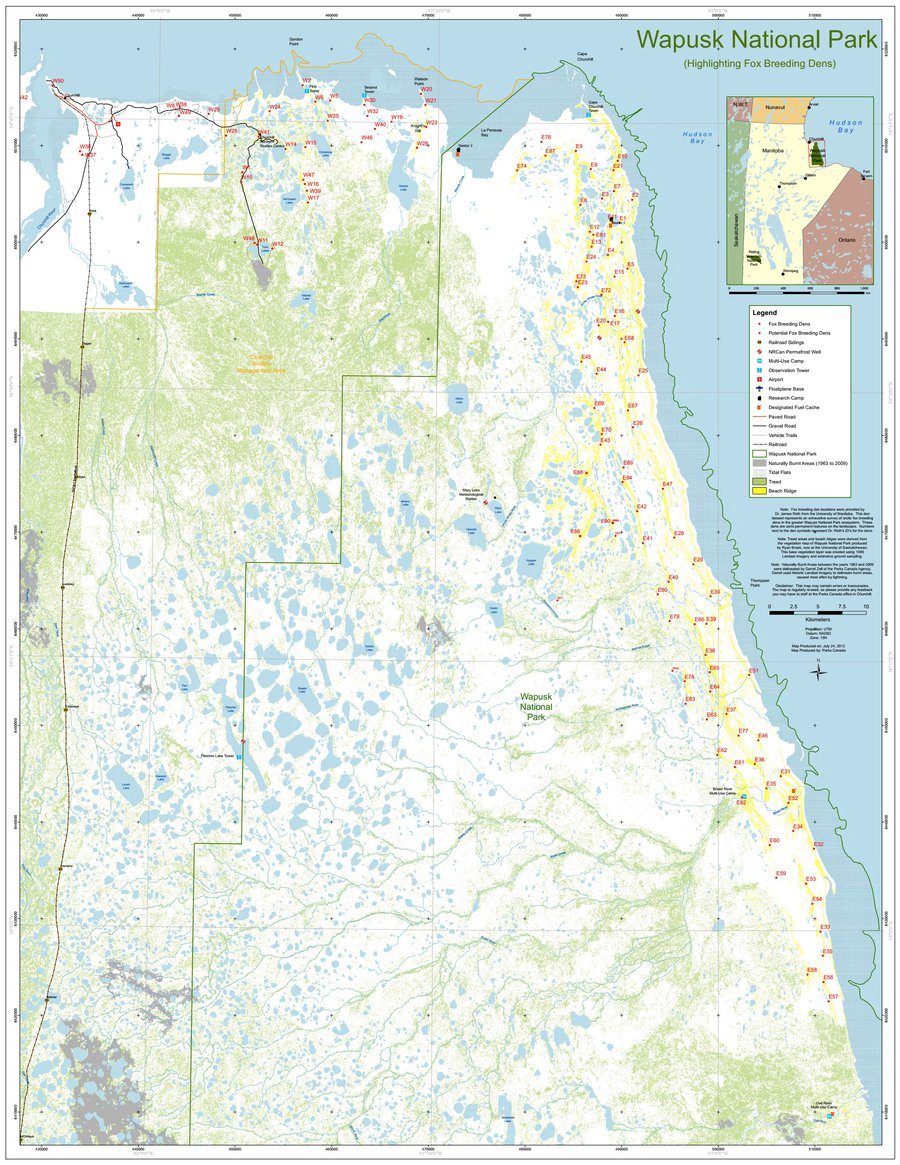
A map of the study area.
In addition to prey and sea ice decline, milder winters are facilitating the expansion of red foxes onto the tundra. Foxes in the Arctic typically form monogamous breeding pairs and settle in dens for reproduction around March-April. The choice of a den is crucial for breeding foxes as den location in regards to access to prey resources may influence pup survival. Red and Arctic foxes are likely competing for resources such as prey and dens, with red foxes expected to out-compete Arctic foxes. Another detrimental effect of red fox expansion includes sharing pathogens. Red fox pathogens can spill over to Arctic foxes, thereby inducing northward expansion of diseases like rabies, therefore northward expansion of disease may not only impact Arctic species but Northern human communities as well. Additionally if competition with red foxes over land resources causes Arctic foxes to increase their consumption of marine resources, we expected Arctic foxes to be exposed to increased level of mercury in the future, which may cause harmful effects on population health. All the aforementioned factors are likely to cause decline in Arctic fox populations.
Our research focuses on winter, because it is a crucial period for the foxes. First, winter is a period of food scarcity and harsher conditions, therefore we expect competition between red and Arctic foxes to be stronger in winter than in summer. So winter is an obvious period for us to study competition between the two species. Winter is also obviously the only time of the year when foxes may forage on the sea ice, and therefore for us to study that phenomenon. Logistically, it is also easier to work during that time, covering large distances on our snowmobiles. Finally, when foxes settle into dens for reproduction at the end of winter, it is easier for us to find them!
During winter we trap foxes to equip them with satellite collars, survey over 115 fox dens along the coast of the Hudson Bay, and dissect fox carcasses. With the data from satellite collars we study how foxes use and share their habitat while the den survey allows us to determine the fox species occupying each den and collect frozen fecal samples for genetic analysis. Fecal DNA and genetic analysis allow us to identify prey species and fox individuals. Winter is also trapping season in Churchill and fox pelts are an important source of income for many Northern communities. The trappers of Churchill participate in our research by providing us with fox carcasses after they have taken the pelt. Those carcasses collected and organized by our indispensable partners at the Churchill Northern Studies Centre (CNSC), are a source of invaluable information. We dissect the fox carcasses and sample different tissues, then use samples to analyse long term winter diet, virology and contaminants levels.
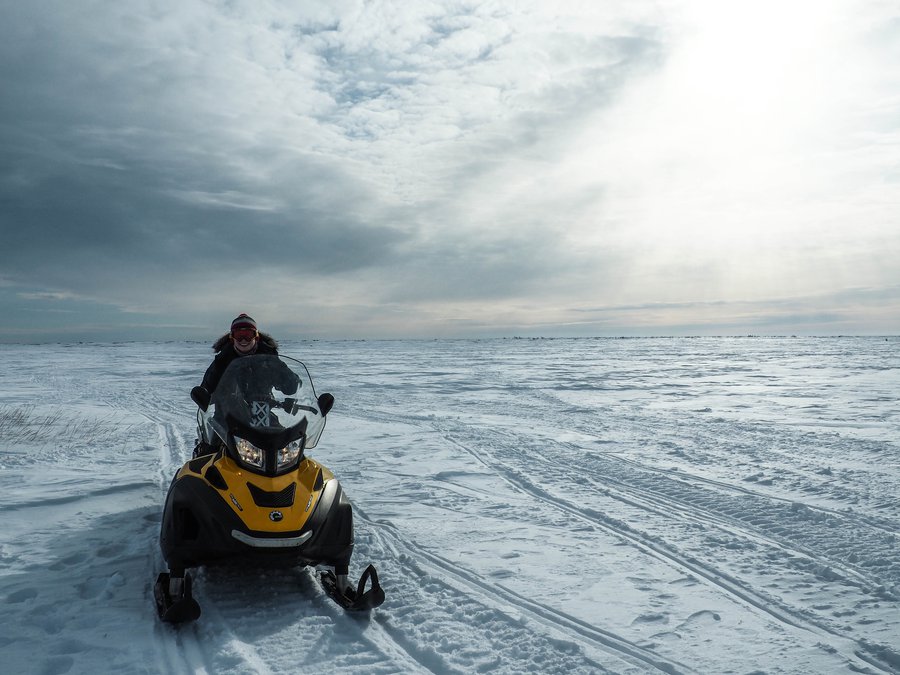
Megan Dudenhoeffer on a snowmobile in Wapusk National Park (Photo © C. Warret Rodrigues)
After a successful preliminary trial collaring 6 foxes between Broad and Owl River, in Wapusk National Park, in 2017, we returned in early April 2018 with 18 more satellite collars to deploy and 115 dens to check. Based on our 2017 successful Winter field season, our plan was to spend a few days surveying and sampling dens around Churchill and in Wapusk National Park, and then trap foxes on occupied dens. During our winter field season, we stay in 3 different camps located in Wapusk National Park: Nester One, Broad River, and Owl River and when in Churchill we call the CNSC our home base.
Our 2018 winter field research team includes PhD student, Chloé Warret-Rodrigues, who’s thesis research focuses predominantly on red fox and Arctic fox interactions, MSc student Jessica Lang, who focuses on landscape modification effects of red foxes in the boreal forest, and MSc student Megan Dudenhoeffer, who uses genetic methods to identify dietary items and population dynamics. Our advisor, Dr. James Roth, was unfortunately tied to his courses for the beginning of our trip but joined us after a week. We were all very excited about the prospect of trapping foxes and snowmobiling all over the tundra, but when we left Winnipeg on April 1st, 2018, we did not know that the weather had other plans for us!
Our first challenge started as we began to assess fox den occupancy: there was too much snow! While out in the park during our first few days we got caught in a blizzard, forcing us to abandon den checks and return to the Churchill Northern Studies Centre. We only had one month to complete all our data collection, so we began dissecting fox carcasses while we waited for the weather to clear up, and for Jim to arrive. The winds died down, and the blue sky showed up again, so we finally snowmobiled back to Nester One from the CNSC and immediately began trapping to make up for lost time.
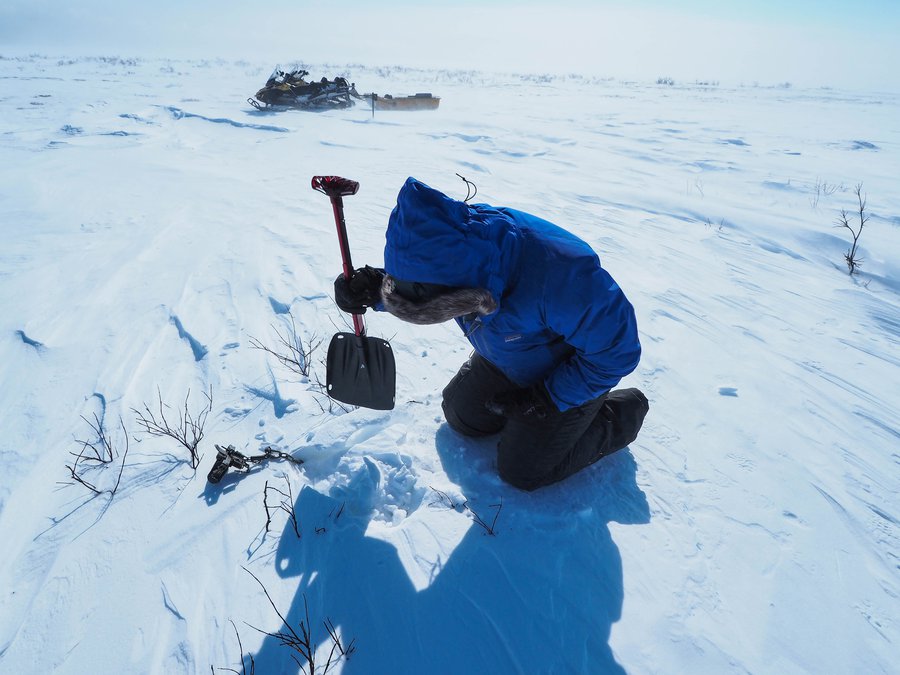
Megan Dudenhoeffer digging an anchor for a leg hold trap (Photo © C. Warret Rodrigues)
Flash forward to April 10th, 3am we were up checking fox traps, with only light from the northern lights. As the neon colors danced above us in the sky, we snowmobiled between dens to rebait each trap station, meticulously placing smelly sardines and cat food next to the trap. Our tired eyes were wandering to the night sky as we worked, drinking in the magnificent light show. Fox traps must be checked every 4-6 hours, making for a strange sleep schedule. When we approach the traps, we hold our breath waiting for a glimpse of a fox, squinting to try to see through the darkness. If we’ve caught a fox, we quietly approach then quickly physically restrain the fox, remove its paw from the soft-catch leghold trap, deploy the collar, collect samples and release. We do this process as fast as possible to minimize animal stress, with our personal record being 11 minutes from arrival to release. But unfortunately, clear skies were not here to stay. Snow began blowing at speeds of 70km/h, causing the traps becoming covered in snow, preventing them from firing. We stubbornly decided to ignore the weather and carried on with the trapping, spending hours rebuilding each trap station before returning to camp and collapsing in bed, wondering if we’d ever catch a fox.
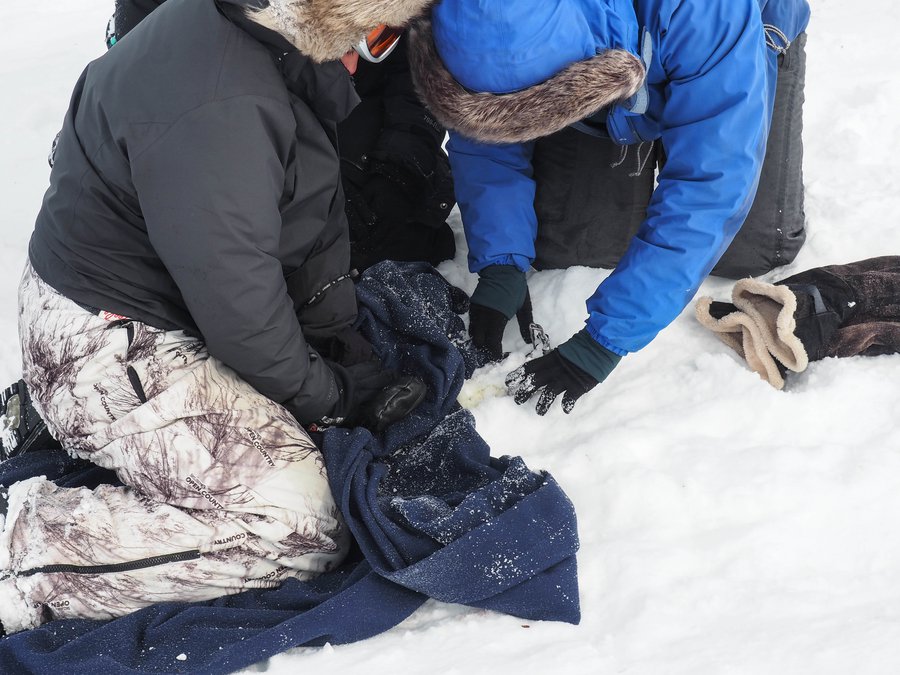
Megan, Chloe, and Jess releasing an Arctic fox paw from a soft leg-hold trap (Photo © J. Roth)
Because the weather initially prevented us from performing our den surveys, in addition to checking fox traps, we still had to visit each den. So we gave up on sleep and decided to survey dens in between trap checks, because data comes first! We’d race up and down the coast checking dens in the hours between checking fox traps. Finally, after two days of nice weather we managed to catch three foxes, which made us think that foxes are cleverer than us: they don’t go out when the weather is raging! In addition to capturing the three foxes, we had also visited 20 dens and collected a few hundred fecal samples. We returned to Churchill for a few days to stock up on food and drop Jim off at the airport. We then went back to Nester One, our plan to try and get out the remaining 13 collars and check the remaining dens before the end of April. We thought we had plenty of time, it was only the 18th, but the weather wasn't done with us.
On our third trip out to the park there wasn’t enough snow! The snow had begun to melt, making it impossible to snowmobile to dens we had traps on, so we decided to switch camps. We hoped there would be more snow at the southern Broad River Camp, and we needed to assess occupancy and collect fecal samples from the southern-most dens. Unknowingly, after we’d traveled most of the distance there, we found ourselves trapped by the bare tundra, there was no snow left. We hopped between patches of snow finally making it to Broad River Camp after hours of tedious travel.
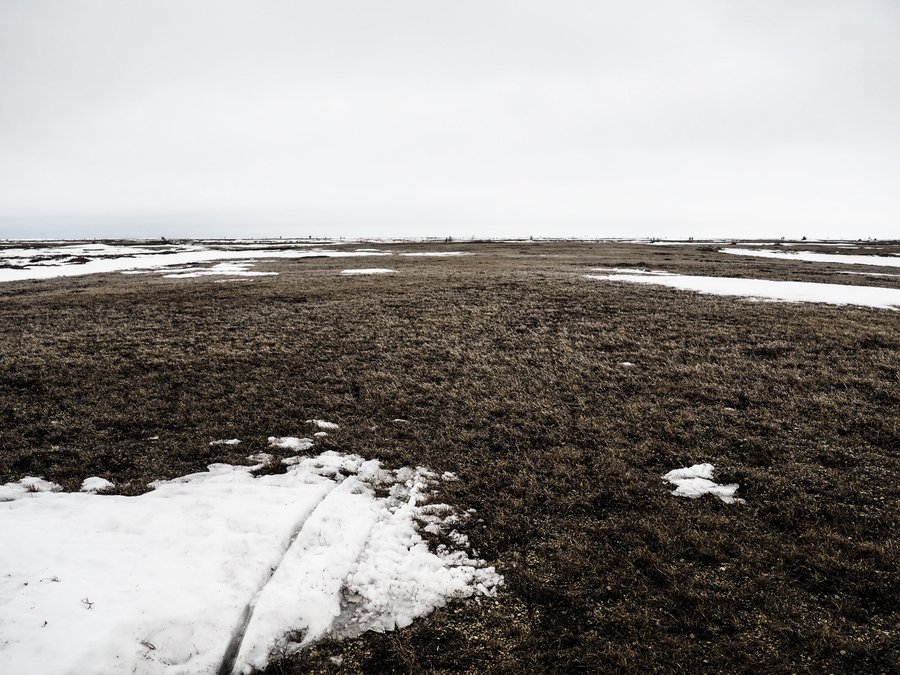
The lack of snow at Broad River and our snowmobile tracks (Photo © C. Warret Rodrigues)
We tried to trap for foxes around Broad River, tying traps to trees where there wasn’t snow. The remaining snow patches were riddled with fox tracks, but our bait remained untouched... Until the last day. We collected traps as we prepared to leave the park, thinking of the dens we did not check and the collars we didn’t deploy. As we packed up our belongings, we spotted a beautiful red fox, eating all the remaining bait from the trap stations we had just removed. We returned to the CNSC with heavy hearts and spent our last days dissecting fox carcasses, making the vow to capture that clever little fox in June when we come back.
We experienced firsthand the Arctic warming. While most people dream of sunny summer days impatiently waiting in the warmth of their house for the winter to end, we thrive in the cold! Our data collection and logistics depends on a cold and snowy winter. But even if the weather was against us this year, we are lucky in having our faithful partners the CNSC, the trappers of the Churchill community, and Parks Canada, whose dedicated help allowed us to mitigate our unsuccessful data collection. Their help was not only logistical. While unhappy about the data we couldn’t collect, there’s nothing as exhilarating as snowmobiling across the tundra, catching foxes, and living the tundra lifestyle, with research partners we now see as friends.
To end our story on a positive note, during our June 2018 field season we managed to trap another 2 foxes, and one of them was the clever red fox that evaded us in April. We finally out-foxed it!
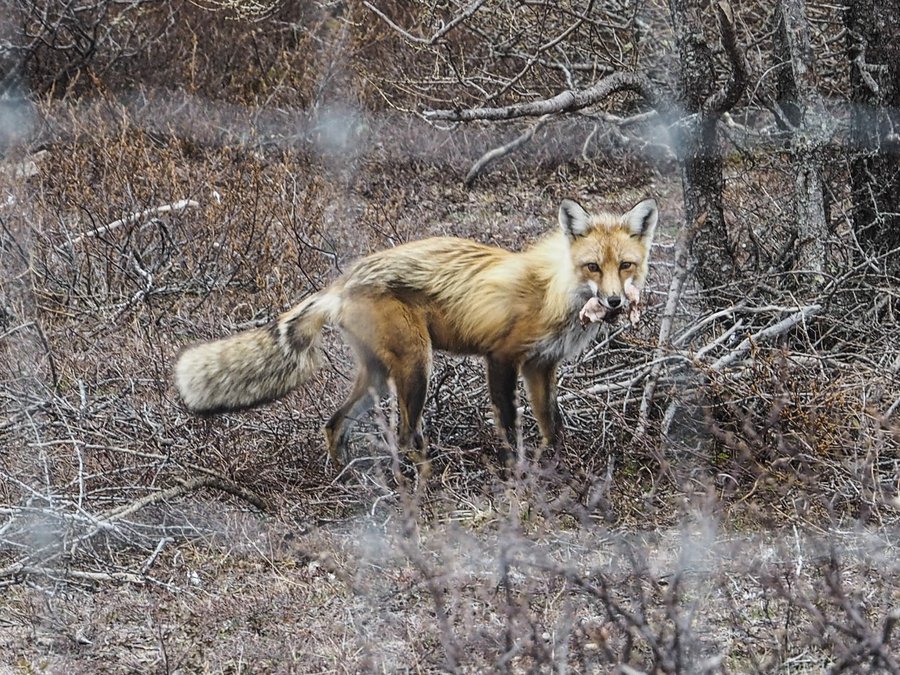
The fox that taunted us in April was caught and collared in June, here she is pictured stealing bait from one of our trap stations without getting caught (Photo © C. Warret Rodrigues)
Banner Image: Arctic fox at den in winter. (Photo © C. Warret Rodrigues)
